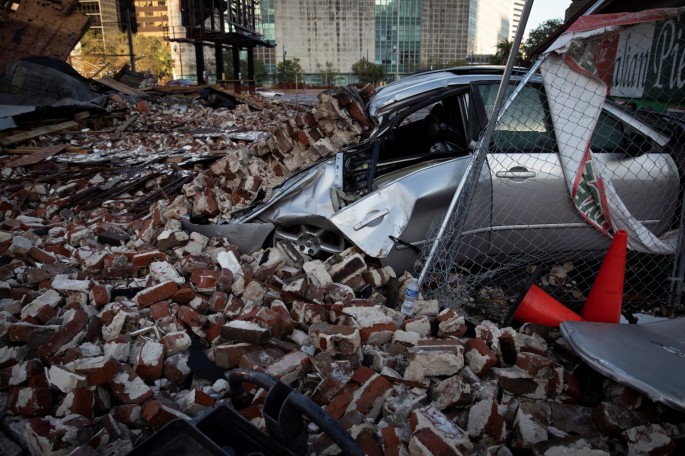South Louisiana braced for a month without electricity and reliable water service in the wake of Hurricane Ida, one of the most powerful storms ever to hit the U.S. Gulf Coast, as people faced suffocating heat and humidity.
By early Tuesday, about 1.3 million customers were without power about 48 hours after the storm made landfall, most of them in Louisiana, according to PowerOutage https://poweroutage.us, which gathers data from U.S. utility companies.
The storm killed at least four people, officials said, a toll that perhaps would have been much larger if not for a fortified levee system built around New Orleans after the city was devastated by Hurricane Katrina 16 years ago. (Graphic of Hurricane Ida hitting Gulf Coast https://tmsnrt.rs/3yrcULP)
Officials were unable to complete a full damage assessment because downed trees clogged roads, U.S. Federal Emergency Management Agency chief Deanne Criswell said.
Compounding the suffering, parts of Louisiana and Mississippi were under heat advisories, with a heat index in much of the area reaching 95 degrees Fahrenheit (35 degrees Celsius) on Tuesday, the National Weather Service said.
Louisiana Governor John Bel Edwards said, "Nobody is satisfied" with the estimate that power may not be restored for 30 days. He expressed hope the 20,000 line workers in the state and thousands more en route could finish sooner.
"We all want air conditioning....Even if you have a generator, after so many days they fail," Edwards said.
At Ochsner St. Anne Hospital southwest of New Orleans, 6,000-gallon tanker trucks pumped fuel and water into tanks behind the hospital to keep the air conditioning running. The medical center closed to all but a few emergency patients.
New Orleans' restaurants, many of which had closed ahead of the storm, also faced an uncertain future due to a lack of electricity and other infrastructure, mirroring - at least for now - the issues that plagued businesses for weeks in the wake of Katrina.
"This is definitely feeling like Katrina," said Lisa Blount, the public relations director at Antoine's, a French Quarter landmark and the city's oldest eatery. "To hear the power is potentially out for two to three weeks, that is devastating."
Even the power generators were hazardous. Nine people in St. Tammany Parish northeast of New Orleans were taken to the hospital overnight for carbon monoxide poisoning from a gas- fueled generator, local media reported.
Power officials have told leaders in Jefferson Parish south of New Orleans that its roughly 440,000 people may have to manage without electricity for a month or longer after utility poles toppled across the county, Councilman Deano Bonano said in a telephone interview.
"The damage from this is far worse than Katrina from a wind standpoint," said Bonano.
'THEY HAVE NOTHING'
Among the four deaths were two people killed in the collapse of a southeastern Mississippi highway that critically injured 10 others. One man died attempting to drive through high water in New Orleans and another when a tree fell on a Baton Rouge home.
The swampy areas south of New Orleans took the brunt of the storm. High waters finally receded from the highway leading to Port Fourchon, Louisiana's southernmost port, leaving behind a trail of dead fish. Seagulls swarmed the highway to eat them.
Port Fourchon suffered extensive damage, and some roads were still not passable. Officials were only allowing emergency responders through to Grand Isle, a barrier island in the Gulf of Mexico. It could take weeks before the roads were fully passable, they said.
A gas station stocked with fuel in Mathews, a community in Lafourche Parish, had a line of cars stretching for at least a mile.
More than half the residents of Jefferson Parish rode out the storm at home, Bonano said, and many were left with nothing.
"There are no grocery stores open, no gas stations open. So they have nothing," he said.
HIGHWAY 'WASHED OUT'
The weakened remnants of the storm dumped heavy rain in neighboring Mississippi on Tuesday as it traveled toward Alabama and Tenneessee. Heavy rainfall and flash flooding were possible on Wednesday in the mid-Atlantic region and southern New England, forecasters said.
Sheriff's deputies in St. Tammany Parish, Louisiana were investigating the disappearance of a 71-year-old man after an apparent alligator attack in the flood waters.
The man's wife told authorities that she saw a large alligator attack her husband on Monday in the tiny community of Avery Estates, about 35 miles (55 km) northeast of New Orleans. She stopped the attack and pulled her husband out of the flood water.
Seeing that his injuries were severe, she took a small boat to get help and came back to find her husband gone, the sheriff's office said in a statement.



























